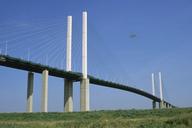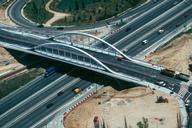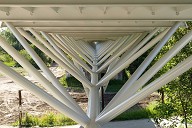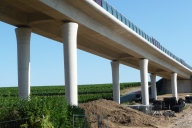Huge Spherical Bearings with 120 MN Superimposed Load
At the Weißenthurm-Neuwied bridge over the river Rhine, the worn PTFE pot bearings were replaced with spherical bearings equipped with the special sliding material MSM®. The challenge was their size: With a diameter of 2.4 m and weighing approximately 13 tonnes, they are among the largest structural bearings in Germany. They accommodate vertical loads of up to 120 MN.
Media
MAURER supplies replacement bearings for the Rhine bridge near Neuwied
“Handling alone is a challenge with bearings of this order and limited space on the bridge”, emphasises Michael Ohnheiser from MAURER. Theoretically, smaller bearings would have sufficed for accommodating the enormous loads, but the bearing size had to be adapted to the existing situation.
The Raiffeisen Bridge, built in 1978, is part of the federal road B 256. Some 46,000 vehicles cross the Rhine bridge every day. The 485-metre-long, three-span cable-stayed bridge has single span lengths of 235 m, 38 m, and 212 m, and a total width of 35.5 m.
The A-shaped central pylon supports the cable-stayed central bridge and stands on the Rhine island “Weißenthurmer Werth”. All eight bearings on both pylon piers had to be replaced, as the PTFE in the sliding plates of the existing pot bearings was laterally pressed out due to frequent movements. MSM® spherical bearings from MAURER were installed instead.
MSM® spherical bearings instead of PTFE pot bearings
Spherical bearings allow rotation about all axes with low friction. All sliding surfaces are equipped with the high-performance material MSM®. Compared to conventional Teflon (PTFE), MSM® can withstand at least double the compressions. It can also accommodate at least fivefold accumulated sliding displacements and the 7.5-fold displacement velocity. The service life is specified as 50 years in the corresponding ETA. Since the limit loads are only rarely given, the bearings will actually last longer.
In order to install the modern MSM® spherical bearings, it was necessary that they precisely connect to the plates remaining in the structure. That is the only way to ensure full activation with proper load transmission of the plates into the concrete surfaces. Smaller bearings would have been sufficient for the superimposed load of 120 MN, but they would have caused higher compressions and overloaded the existing structure. The separate cable anchorages preventing uplift forces and the steel restrainers as restraints in the longitudinal and transverse direction, also remained unchanged.
The eight new spherical bearings are moveable in all directions, and equipped with the high-performance sliding material MSM® (MAURER Sliding Material). Four bearings lie on top of each pier. The two larger bearings lying in the inner section of the pier weigh approximately 13 tonnes, have a diameter of 2.4 m and transmit vertical forces of up to 120 MN. “We don’t often have bearings of this size in Germany”, as Ohnheiser is aware. The two smaller bearings lie in the outer section of the pier. They still have a diameter of 1.6 m, weigh 4 tonnes and accommodate approximately 48 MN.
The bearings were replaced from the bridge deck in May/June using a suspended scaffold with “launching track”. The client was Landesbetrieb Mobilität Cochem-Koblenz (LBM). The rehabilitation was carried out by the company aventas.bau.


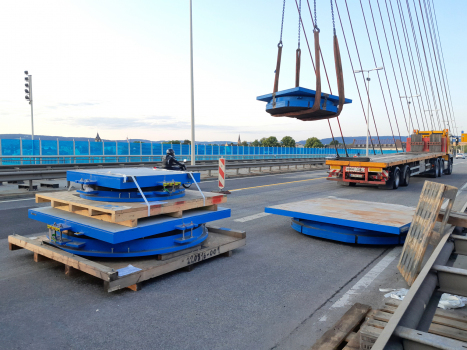
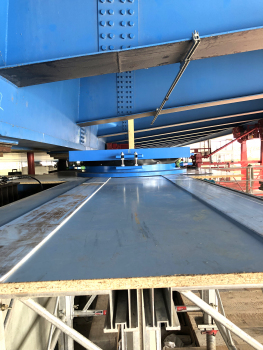
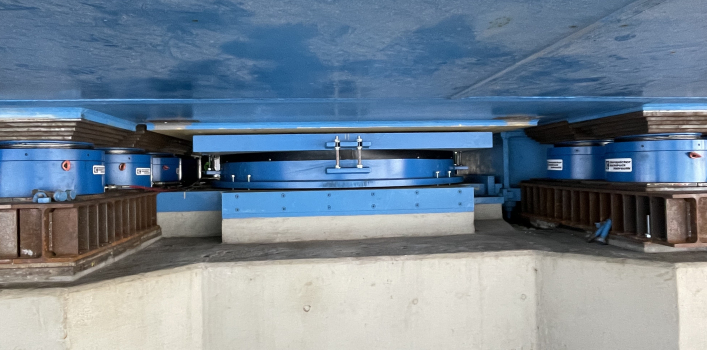
 MAURER SE
MAURER SE 
